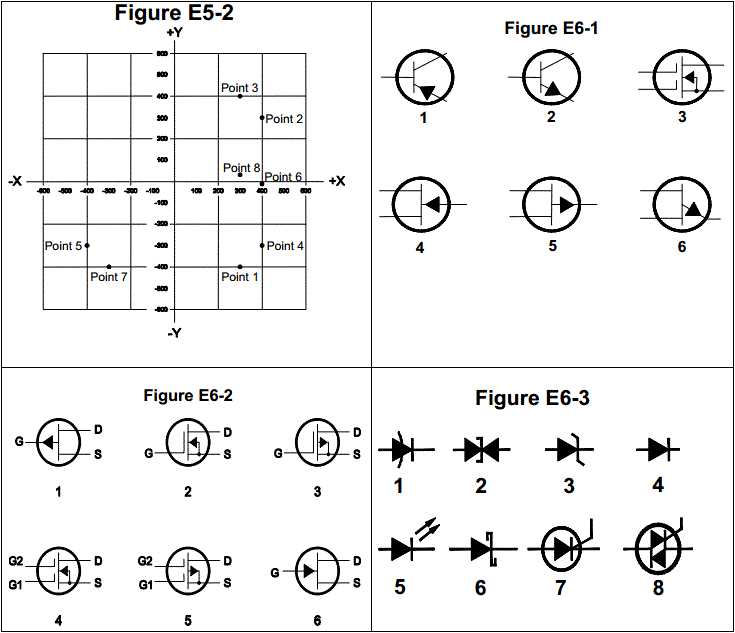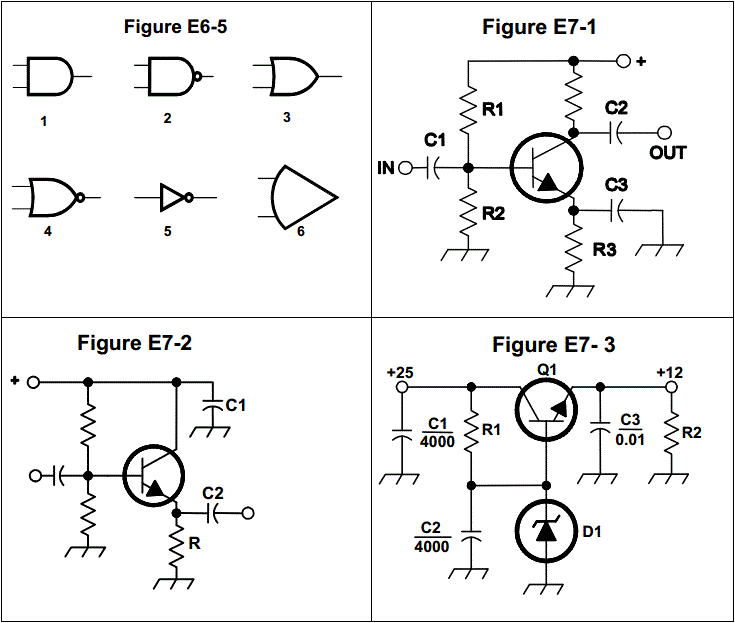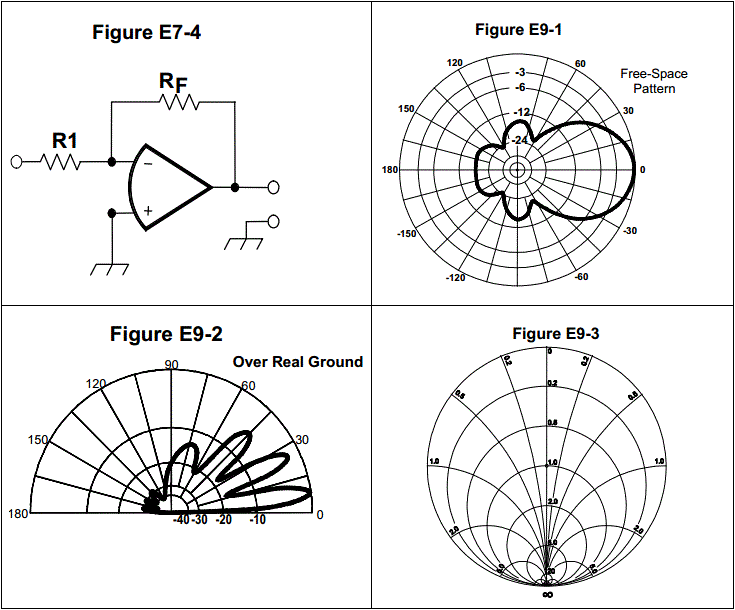Ham Extra License Practice Quiz
• Percentage: 0%; Correct: 0; Total: 0 of 50
E0A03: Which of the following would be a practical way to estimate whether the RF fields produced by an amateur radio station are within permissible MPE limits?
Use a calibrated antenna analyzer
Use a hand calculator plus Smith-chart equations to calculate the fields
Use an antenna modeling program to calculate field strength at accessible locations
All of the choices are correct
E1A06: Which of the following describes the rules for operation on the 60 meter band?
Working DX is not permitted
Operation is restricted to specific emission types and specific channels
Operation is restricted to LSB
All of these choices are correct
E1B03: Within what distance must an amateur station protect an FCC monitoring facility from harmful interference?
1 mile
3 miles
10 miles
30 miles
E1C04: When may an automatically controlled station retransmit third party communications?
Never
Only when transmitting RTTY or data emissions
When specifically agreed upon by the sending and receiving stations
When approved by the National Telecommunication and Information Administration
E1D08: Which VHF amateur service bands have frequencies available for space stations?
6 meters and 2 meters
6 meters, 2 meters, and 1.25 meters
2 meters and 1.25 meters
2 meters
E1E09: What may be the penalty for a VE who fraudulently administers or certifies an examination?
Revocation of the VE's amateur station license grant and the suspension of the VE's amateur operator license grant
A fine of up to $1000 per occurrence
A sentence of up to one year in prison
All of these choices are correct
E1F14: Under what circumstances might the FCC issue a "Special Temporary Authority" (STA) to an amateur station?
To provide for experimental amateur communications
To allow regular operation on Land Mobile channels
To provide additional spectrum for personal use
To provide temporary operation while awaiting normal licensing
E2A07: Which of the following types of signals can be relayed through a linear transponder?
FM and CW
SSB and SSTV
PSK and Packet
All of these choices are correct
E2B12: How are analog SSTV images typically transmitted on the HF bands?
Video is converted to equivalent Baudot representation
Video is converted to equivalent ASCII representation
Varying tone frequencies representing the video are transmitted using PSK
Varying tone frequencies representing the video are transmitted using single sideband
E2C09: How does the spread-spectrum technique of frequency hopping work?
If interference is detected by the receiver it will signal the transmitter to change frequencies
If interference is detected by the receiver it will signal the transmitter to wait until the frequency is clear
A pseudo-random binary bit stream is used to shift the phase of an RF carrier very rapidly in a particular sequence
The frequency of the transmitted signal is changed very rapidly according to a particular sequence also used by the receiving station
E2D04: What is the purpose of digital store-and-forward functions on an Amateur Radio satellite?
To upload operational software for the transponder
To delay download of telemetry between satellites
To store digital messages in the satellite for later download by other stations
To relay messages between satellites
E2E12: Which type of digital communication does not support keyboard-to-keyboard operation?
Winlink
RTTY
PSK31
MFSK
E3A07: What frequency range would you normally tune to find EME signals in the 70 cm band?
430.000 - 430.150 MHz
430.100 - 431.100 MHz
431.100 - 431.200 MHz
432.000 - 432.100 MHz
E3B08: What type of HF propagation is probably occurring if radio signals travel along the terminator between daylight and darkness?
Transequatorial
Sporadic-E
Long-path
Gray-line
E3C04: Which emission mode is best for Aurora propagation?
CW
SSB
FM
RTTY
E4A11: Which of these instruments could be used for detailed analysis of digital signals?
Dip meter
Oscilloscope
Ohmmeter
Q meter
E4B12: What is the significance of voltmeter sensitivity expressed in ohms per volt?
The full scale reading of the voltmeter multiplied by its ohms per volt rating will provide the input impedance of the voltmeter
When used as a galvanometer, the reading in volts multiplied by the ohms/volt will determine the power drawn by the device under test
When used as an ohmmeter, the reading in ohms divided by the ohms/volt will determine the voltage applied to the circuit
When used as an ammeter, the full scale reading in amps divided by ohms/volt will determine the size of shunt needed
E4C11: Which of the following is a desirable amount of selectivity for an amateur SSB phone receiver?
1 kHz
2.4 kHz
4.2 kHz
4.8 kHz
E4D01: What is meant by the blocking dynamic range of a receiver?
The difference in dB between the noise floor and thelevel of an incoming signal which will cause 1 dB of gain compression
The minimum difference in dB between the levels of two FM signals which will cause one signal to block the other
The difference in dB between the noise floor and the third order intercept point
The minimum difference in dB between two signals which produce third order intermodulation products greater than the noise floor
E4E14: What is one type of electrical interference that might be caused by the operation of a nearby personal computer?
A loud AC hum in the audio output of your station receiver
A clicking noise at intervals of a few seconds
The appearance of unstable modulated or unmodulated signals at specific frequencies
A whining type noise that continually pulses off and on
E5A05: What is the magnitude of the current at the input of a series RLC circuit as the frequency goes through resonance?
Minimum
Maximum
R/L
L/R
E5B06: How long does it take for an initial charge of 800 V DC to decrease to 294 V DC in a 450-microfarad capacitor when a 1-megohm resistor is connected across it?
4.50 seconds
9 seconds
450 seconds
900 seconds
E5C19: Which point on Figure E5-2 best represents that impedance of a series circuit consisting of a 400 ohm resistor and a 38 picofarad capacitor at 14 MHz?
Point 2
Point 4
Point 5
Point 6
E5D06: In what direction is the magnetic field oriented about a conductor in relation to the direction of electron flow?
In the same direction as the current
In a direction opposite to the current
In all directions; omnidirectional
In a direction determined by the left-hand rule
E6A02: Which of the following semiconductor materials contains excess free electrons?
N-type
P-type
Bipolar
Insulated gate
E6B05: What characteristic of a PIN diode makes it useful as an RF switch or attenuator?
Extremely high reverse breakdown voltage
Ability to dissipate large amounts of power
Reverse bias controls its forward voltage drop
A large region of intrinsic material
E6C10: In Figure E6-5, what is the schematic symbol for a NOR gate?
1
2
3
4
E6D15: What is the principle advantage of liquid-crystal display (LCD) devices over other types of display devices?
They consume less power
They can display changes instantly
They are visible in all light conditions
They can be easily interchanged with other display devices
E6E02: Which of the following factors has the greatest effect in helping determine the bandwidth and response shape of a crystal ladder filter?
The relative frequencies of the individual crystals
The DC voltage applied to the quartz crystal
The gain of the RF stage preceding the filter
The amplitude of the signals passing through the filter
E6F07: What is a solid state relay?
A relay using transistors to drive the relay coil
A device that uses semiconductor devices to implement the functions of an electromechanical relay
A mechanical relay that latches in the on or off state each time it is pulsed
A passive delay line
E7A10: What is a truth table?
A table of logic symbols that indicate the high logic states of an op-amp
A diagram showing logic states when the digital device's output is true
A list of inputs and corresponding outputs for a digital device
A table of logic symbols that indicates the low logic states of an op-amp
E7B17: Why are third-order intermodulation distortion products of particular concern in linear power amplifiers?
Because they are relatively close in frequency to the desired signal
Because they are relatively far in frequency from the desired signal
Because they invert the sidebands causing distortion
Because they maintain the sidebands, thus causing multiple duplicate signals
E7C08: What kind of digital signal processing audio filter might be used to remove unwanted noise from a received SSB signal?
An adaptive filter
A crystal-lattice filter
A Hilbert-transform filter
A phase-inverting filter
E7D15: What is the purpose of a "step-start" circuit in a high-voltage power supply?
To provide a dual-voltage output for reduced power applications
To compensate for variations of the incoming line voltage
To allow for remote control of the power supply
To allow the filter capacitors to charge gradually
E7E10: How does a diode detector function?
By rectification and filtering of RF signals
By breakdown of the Zener voltage
By mixing signals with noise in the transition region of the diode
By sensing the change of reactance in the diode with respect to frequency
E7F07: What determines the accuracy of a frequency counter?
The accuracy of the time base
The speed of the logic devices used
Accuracy of the AC input frequency to the power supply
Proper balancing of the mixer diodes
E7G13: What is meant by the term op-amp input-offset voltage?
The output voltage of the op-amp minus its input voltage
The differential input voltage needed to bring the open-loop output voltage to zero
The input voltage needed to bring the open-loop output voltage to zero
The potential between the amplifier input terminals of the op-amp in an open-loop condition
E7H13: What is the capture range of a phase-locked loop circuit?
The frequency range over which the circuit can lock
The voltage range over which the circuit can lock
The input impedance range over which the circuit can lock
The range of time it takes the circuit to lock
E8A12: What type of information can be conveyed using digital waveforms?
Human speech
Video signals
Data
All of these choices are correct
E8B12: What is digital time division multiplexing?
Two or more data streams are assigned to discrete sub-carriers on an FM transmitter
Two or more signals are arranged to share discrete time slots of a data transmission
Two or more data streams share the same channel by transmitting time of transmission as the sub-carrier
Two or more signals are quadrature modulated to increase bandwidth efficiency
E8C07: What is the necessary bandwidth of a 4800-Hz frequency shift, 9600-baud ASCII FM transmission?
15.36 kHz
9.6 kHz
4.8 kHz
5.76 kHz
E8D10: What type of meter should be used to monitor the output signal of a voice-modulated single-sideband transmitter to ensure you do not exceed the maximum allowable power?
An SWR meter reading in the forward direction
A modulation meter
An average reading wattmeter
A peak-reading wattmeter
E9A02: How much gain does a 1/2-wavelength dipole in free space have compared to an isotropic antenna?
1.55 dB
2.15 dB
3.05 dB
4.30 dB
E9B04: What may occur when a directional antenna is operated at different frequencies within the band for which it was designed?
Feed point impedance may become negative
The E-field and H-field patterns may reverse
Element spacing limits could be exceeded
The gain may change depending on frequency
E9C07: What type of antenna pattern over real ground is shown in Figure E9-2?
Elevation
Azimuth
Radiation resistance
Polarization
E9D01: How does the gain of an ideal parabolic dish antenna change when the operating frequency is doubled?
Gain does not change
Gain is multiplied by 0.707
Gain increases by 6 dB
Gain increases by 3 dB
E9E12: What is the primary purpose of a phasing line when used with an antenna having multiple driven elements?
It ensures that each driven element operates in concert with the others to create the desired antenna pattern
It prevents reflected power from traveling back down the feed line and causing harmonic radiation from the transmitter
It allows single-band antennas to operate on other bands
It makes sure the antenna has a low-angle radiation pattern
E9F04: What is the typical velocity factor for a coaxial cable with solid polyethylene dielectric?
2.70
0.66
0.30
0.10
E9G09: What third family of circles is often added to a Smith chart during the process of solving problems?
Standing-wave ratio circles
Antenna-length circles
Coaxial-length circles
Radiation-pattern circles
E9H08: What is the function of a sense antenna?
It modifies the pattern of a DF antenna array to provide a null in one direction
It increases the sensitivity of a DF antenna array
It allows DF antennas to receive signals at different vertical angles
It provides diversity reception that cancels multipath signals



